#mixtec design
Explore tagged Tumblr posts
Text
Vintage Mexican Pottery Aztec Calendar Alfareria Jimenez Oaxaca
Intricately carved and with extreme detail, this circa 1950s Aztec calendar plate was made by hand by Alfareria Jimenez of Oaxaca, Mexico.
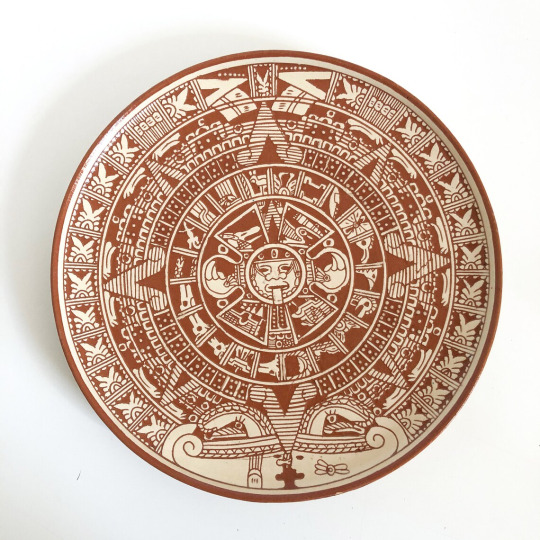
The plate is expertly carved. The geometric pattern for this plate is based on a Mixtec design found in the temples of Mitla, outside of Oaxaca. The design requires hours of work. The redware pottery pieces were dipped in an ivory glaze and then hand tooled to remove glaze in small amounts, leaving the underlying clay to show through. This type of hand-carved Mexican pottery is becoming very hard to find.
The Jimenez family is noted for their craftsmanship in hand-made dinnerware & decorative items. This plate is marked on the back "Alfareria Jimenez Zaragdza # 13 Oaxaca Mexico Calendario Azteca Hecho A Mano".
Item measures 10 ⅝" across. It is in excellent condition with a minor chip on the rim at the bottom. It is shown in two of the photos.
As of 7/4/23, this plate is still available in my Etsy Shop. https://iSearchedandFound.com
#oxaca pottery#zaragoza#zaragoza pottery#jimenez pottery#oxaca bowl#Mixtec#aztec calendar#Alfareria Jimenez#oaxaca mexico#hand-carved#ivory glaze#mixtec design#temples of mitla#collectible plate#Retro#Antique#Nostalgic#Timeless#Vintage#Authentic#Iconic#Rustic#Treasured#Historic#Sentimental
1 note
·
View note
Text

Lunt ”Tiger Claw” Centerpiece sterling silver For Lunt Silversmiths, Zapotec-Mixtec design, sterling silver brazier with obsidian ”claws”
109 notes
·
View notes
Note
Are you still doing grave gold? If so, hands and neck please! I need design inspo
I am always doing Grave Gold. I love appreciating the craftsmanship of the folks who came before us. (Also, whoo shiny things!)

Why just have one ring when you can have a DOUBLE RING. This interesting find is a Late Roman ring (3rd-5th c. C.E.) and features two emeralds and a garnet.

This gorgeous necklace is Mixtec (est. 1325-1525 C.E.) and was made in the region that's now Oaxaca, Mexico. It's composed of gold beads made to look like jaguar teeth and little gold bells. It's located at the Met Museum in New York City.
22 notes
·
View notes
Text
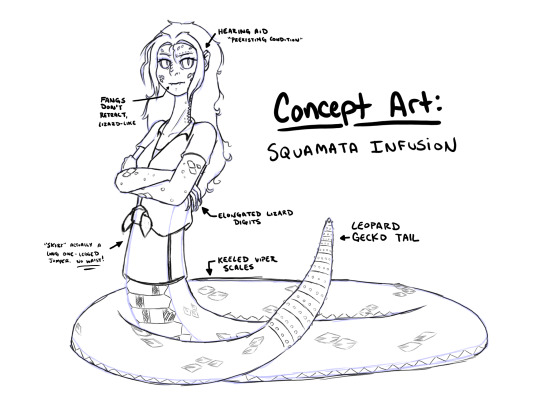

Revisiting some character designs and sketching them in my current style.
What do we think?
Her name is Cindy and she's a Squamata infusion so she has lizard and snake DNA. She's deaf in one ear and hard of hearing in the other. Her hearing aid helps, but she still uses sign language sometimes. She's got Mixtec ancestry. I had originally designed her with mostly just snake elements, but I felt like that's been done to death so I added the leopard gecko tail. I like leopard geckos.
#original character#monster girl#mixtengenetics#webcomic series#webcomics#webcomic#transformation#monstergirl#lamia#gorgon#snake#snake girl
10 notes
·
View notes
Text
Everyone should hire me as a consultant for mesoamerican design motifs (specifically mixtec)
8 notes
·
View notes
Text
Oaxaca - Day Trip
We rented a car and made a day trip south of the city.
Our first stop was San Martín Tilcajete, a town famous for Alebrijes, those colorful and often fanciful carved and painted animals that are found in Oaxaca. They were originally invented by an artist in Mexico City, who saw them in a dream. He made them out of paper mache. Later they came to Oaxaca where the woodcarvers picked up on the idea, but carve them from copal wood.
Jacobo and Maria Angeles are the most famous and successful of the alebrije makers. The quality of their work has always been outstanding in terms of inventiveness, sculpture design, painting and finishing. Their work was always expensive, usually thousands of dollars for a piece when much of the work in shops in Oaxaca ranged from a few dollars to less than a hundred.
But their impact on the market was clearly visible on this trip. Many artists are emulating their style. They are asking a lot more than the older style work seen in shops and street markets but still an order of magnitude less than the Angeles.
This panther is a good example of this new grade of work.
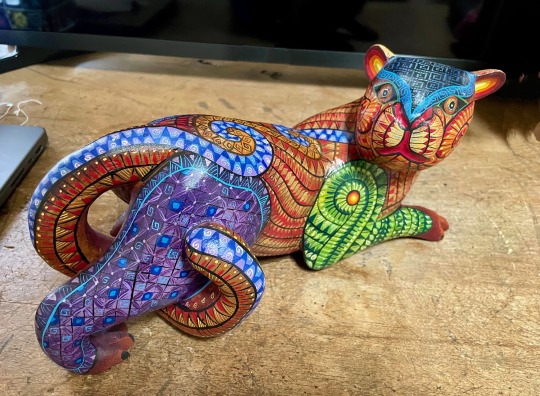
The pose is natural and well-shaped, the painting is intricate and well-done. The finish is not as good as the Angeles work but it was hundreds of dollars not thousands.
The Angeles operation has grown considerably in the 15 years since we visited. They now employ over 200 people!

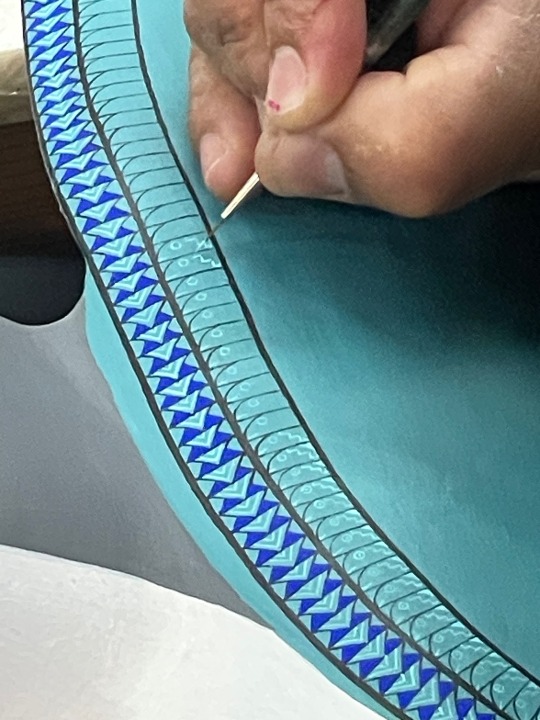
That is very finely detailed painting!
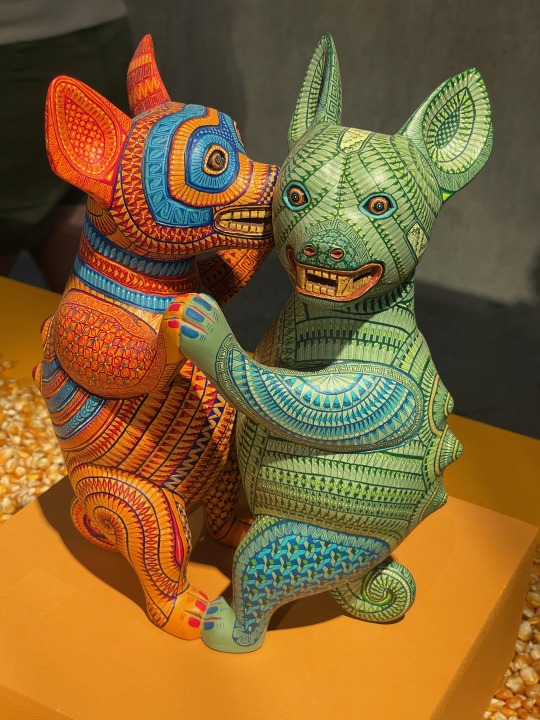
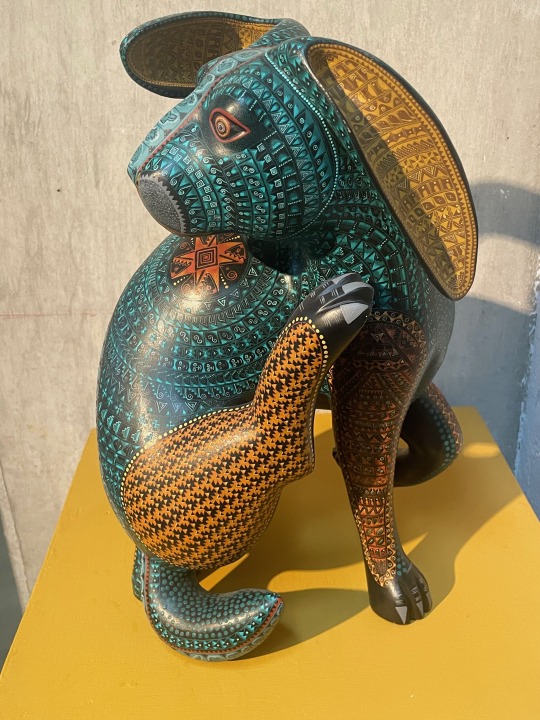
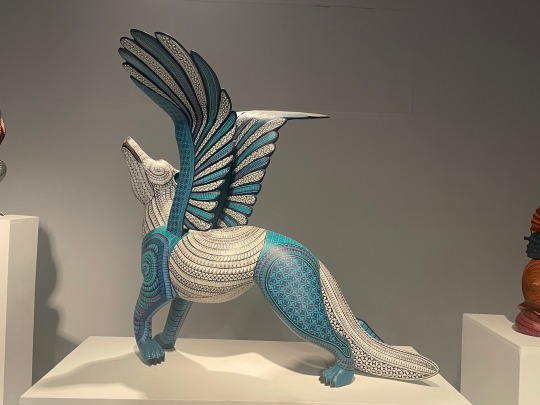
But the prices have increased enough to convince us that the one piece we own is enough.
They have also expanded their operations beyond the alebrijes. Seeing how much copal wood was being cut they planted hundreds of trees outside of town. In the middle of those trees one of the younger generation has opened a restaurant named Almú. It is in amongst the trees of the plantation and is a classic open air restaurant. But more rustic than the large one we were at on Christmas Day.

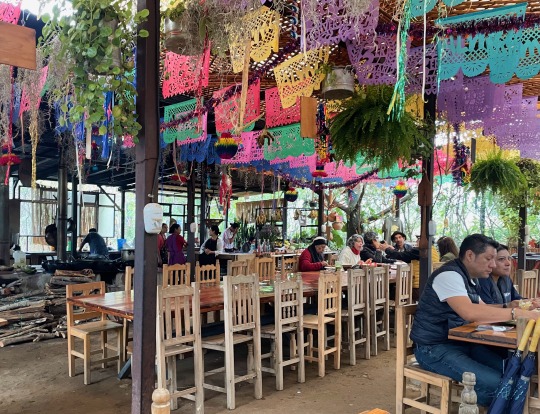


They cook over traditional open wood fires and on clay comals. The menu is handwritten in a notebook. The food was very good and the atmosphere was great.
In the plantation there was a several story tower with a viewing deck on the roof. It had a great view across the valley to the mountains beyone.


The other goal for the day was to visit a couple more of the Dominican convent churches When Cortez was made governor of the Oaxaca area he invited the Dominican order to help Christianize the populace. So in the early 1500's they proceeded to build large churches with attached monasteries in towns throughout the area.
Last year we traveled to the Mixtec highlands and visited three of them. This year we noted a couple more south of San Martín Tilcajete and decided to check them out.
The first was in Santa Ana Zegache. It was beautifully painted.
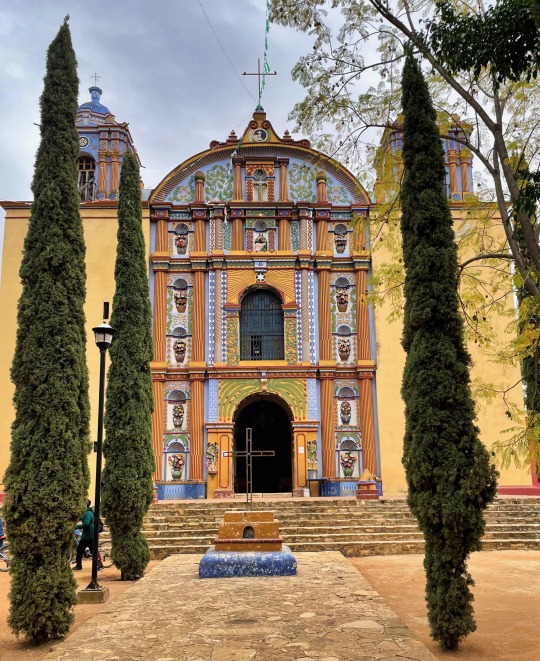
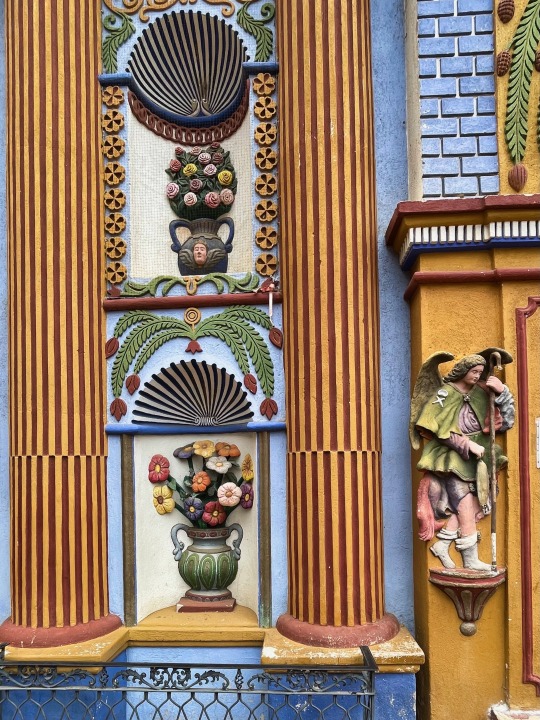

The paint has been kept up well.
Inside was also painted.



The large retablos were also in good shape.
The town is off the main road and quite small these days, so it was especially nice to see the attention they have paid to keeping the church in good shape.
The other stop was in Ocotlán Morales.
This town is on the main road to the coast and is a lot bigger.
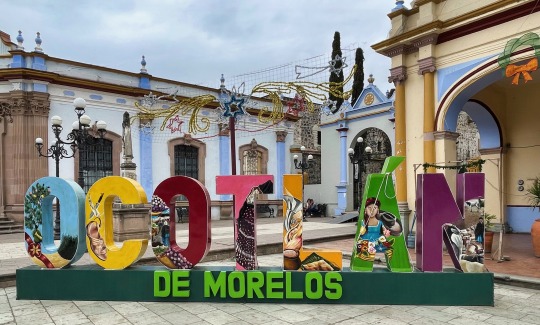
There's a large market building off the main square, which we didn't visit.
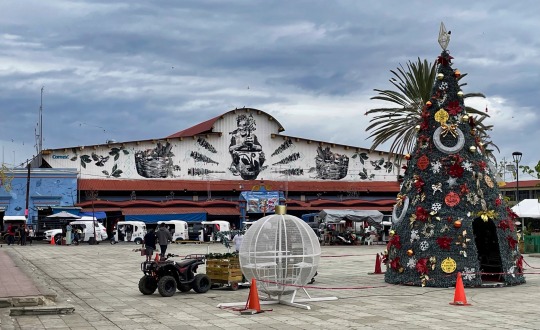
But the church was similar size and configuration. But the details are different. I am amazed that all six of the Dominican churches and monasteries have been so different architecturally given they were built by one organization over only a few years.


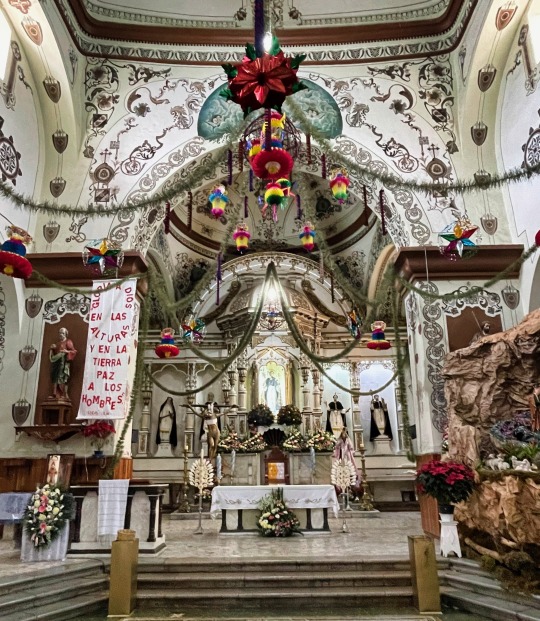
To the right of the main altar one of the statues is of St. Peter Martyr with an Axe in his head. He was killed by Cathars during the church's Albigensian Crusade against the Cathars. In the statue he seems pretty unfazed by the axe. In real life it didn't go so well.
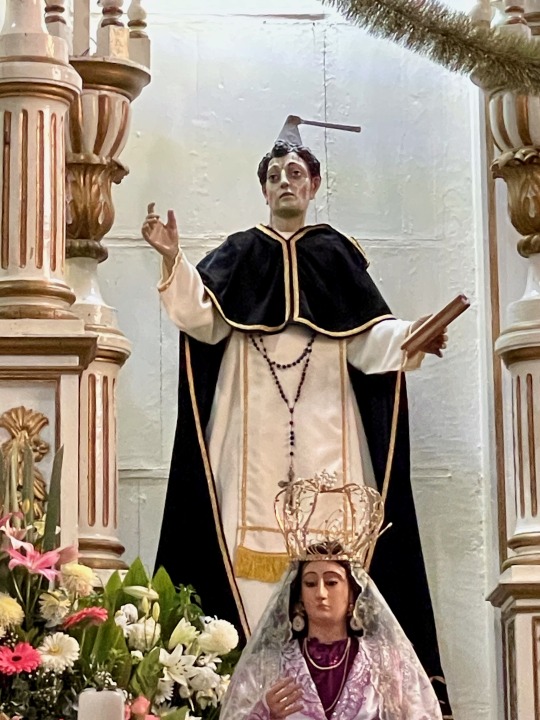
The monastery building is still in good shape and is currently used as a museum to Rodolfo Morales, a very famous local painter and one of the principal contributors to Oaxacan becoming a center for the arts.
We couldn't take photos in the little museum, but in the Museum of Oaxacan Painters in central Oaxaca there is a large painting by him.

This is very typical, showing the fields with the mountains in the background, women carrying baskets of fruit and flowers, a town square, church, colonial building, Mexican flag and angels overhead draped in the colors of the flag.
0 notes
Photo
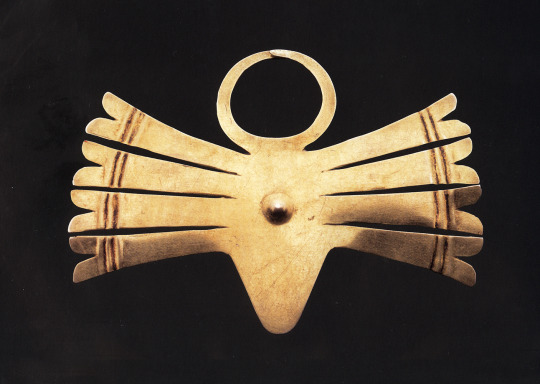
Butterfly nose pendant, Mixtec Gold Artifacts (https://www.latinamericanstudies.org/mixtec-gold.htm)
134 notes
·
View notes
Photo

Mosaic Mask, Aztec/Mixtec (Possibly Xiuhtecuhtli), 1400-1521,
Mask (human face, possibly representing Xiuhtecuhtli) made of cedro wood (Cedrela odorata) and covered in turquoise mosaic with scattered turquoise cabochons.
The pierced elliptical eyes worked in mother-of-pearl (Pinctada mazatlanica) and the teeth are made of conch (Strombus) shell, although two are modern synthetic replacements. The eyelids were gilded.
The interior surface of the mask is painted with cinnabar. The wood was carved to produce a curve and the underlying contours of the face.
Turquoise, mother-of-pearl, cedrela wood, conch shell, cinnabar, pine resin,
Height: 16.80 cm, Width: 15.20 cm, Depth: 13.50 cm,
The British Museum
#art#design#mask#mosaic#aztec#mixtec#god#xiuhtecuhtli#cedro wood#turquoise#mother-of-pearl#conch#shell#cinnabar#history#style#archeology#antiquity#thebritishmuseum
37 notes
·
View notes
Text

Double-Headed Serpent Pectoral
Aztec/Mixtec Turquoise
Mosaic, 15th–16th Century, A.D.
#Double-Headed Serpent Pectoral#art#Pectoral#design#style#jewelry#Aztec/Mixtec Turquoise#mosaic#15th–16th Century A.D.
32 notes
·
View notes
Photo

Yalitza Aparicio, 2019
2 notes
·
View notes
Note
Hi there, I was wondering your thoughts on artists who leave the race of their characters "up to interpretation" or purposefully remain obtuse so they can ride both sides of the fence? example, a white artist drawing a white character with medium-dark skin and when POC asked to clarify their race so they could be respectful when drawing, the creator says "all i can say is they're nonwhite". Do you think that is dubious? As if they want props for being diverse without the responsibility that comes with having a nonwhite character?
(and i know it sounds confusing about "white character" but what i mean is the character can very easily be interpreted as white by the fandom and gain popularity, while another side could assume they're X race based on their skin, so creator benefits that way too instead of clarifying)
Hey!! I know what you're getting at. I think it can potentially depend on who's doing it and what the character is for?
Like if it's just an artist drawing their OC, and maybe they don't have all the backstory or character details worked out yet, or if they literally just wanted to do some character design practice so therefore they don't really have a full backstory in mind), and if they responded with something like your example when asked what the characters' ethnicity is, then it's less dubious. That could potentially be a case of not necessarily trying to benefit off of both sides.
But if it's an artist doing something like a webcomic, or something similar, then knowing a characters' ethnicity is more important. Them refusing to specify could get into the territory of homognizing multiple cultures and reinforce the idea that nonwhite cultures are all the same. Even if they specified something like "They Native American" or "they're Black" or "they're Asian" it's STILL doing this: like, if they're Native, then are the First Nations Canadian, Indigenous Mexican, Native from the Caribbean, are they Indigenous and Brazilian? What tribe(s) are they? Are they Inuk, Mixtec, Taino, Kayapo, or another tribe? If they're Black, are they Jamaican Canadian, Khoisan, Gullah Geechee, Somali-British, Afro Russian, or Aboriginal Australian? If they're Asian, are they Telugu, Armenian, Han Chinese, Bhutanese, or Kinh Vietnamese? All of these cultures can be VERY different from each other (even if, depending on geography and history, there could be overlap & similarities), so these distinctions are important. I think that IS dubious, if they do this.
White artists already get WAY more attention and praise for having nonwhite OC's in their art than actual artists of color, so when they do this it gets REAL sketchy real fast, and kind of feels like they know what they're doing, and they do it for praise. Like if they don't put in the effort in their nonwhite characters the way they do with their white characters, then it's definitely racist, and they're just riding with the approval in the way you say.
25 notes
·
View notes
Photo


shield (?); religious/ritual equipment (?); disc (?); regalia; mosaic
Cultures/periods: Aztec or Mixtec
Production date: 1400 - 1521
Findspot: Mexico
Provenience unknown, possibly looted
Shield, or disc, with mosaic design depicting the principal divisions of the Aztec universe. Made from pine (Pinus) wood, with resin adhesive and mosaic of turquoise and three types of shell: conch (Strombus), thorny oyster (Spondylus princeps) and mother-of-pearl (Pinctada mazatlanica). Parts of the design are worked in gilded resin relief. A band of now undecorated wood around the circumference of the shield is pierced by a series of more or less regularly spaced holes, which might have been used to attach feathers to the shield. In addition, there are numerous holes in the body of the shield which from the back appear to be located at random but are in fact positioned and shaped very precisely to coincide with particular elements in the mosaic design.
The mosaic design on the shield portrays the principal divisions in the Aztec universe. The overall circular shape corresponds to the surface of the earth. At its centre is a circle of mosaic with four rays still partially outlined by red Spondylus princeps and conch shell. The four rays emanating from the solar disc divide the earth into four quarters. In each quarter stands a sky bearer with eyes, teeth and ear ornaments formed of mother-of-pearl shell. The hands are represented by incised mother-of-pearl and pitted orange Spondylus shell.
Solar discs feature on the design of many shields and may reflect the association between Tonatiuh, the sun, and turquoise. Tonatiuh, among the most prominent of the sky gods, was central to the cult of war, which sought to obtain captives and hearts for sacrifice to the sun. The sun was often depicted as a warrior with a rayed solar disc, and the significance of solar discs on mosaic shields probably related to the symbolism of warfare in their ceremonial use. The shield also incorporates the image of a great serpent emerging from toothed jaws and coiling skywards. The tail of the serpent is plumed on its lowermost coil and the head bears a large fang of white conch shell. The eye is made from mother-of-pearl shell and the jaw is outlined using reddish-pink Spondylus princeps and conch shell. One side of the serpent's body is bordered by small studs of pine resin, the same resin that was used to fix the tesserae to the wood. Each of the studs was formed individually on top of the resin layer beneath and then covered by gold foil. Some of the studs retain their original foils, complete with the small falls and puckers in the gold that were inevitably formed when the flat foils were pressed over the domed studs.
The body of the serpent winds sinuously upward through the design. At the top are the flowering branches of a tree, the trunk of which, hidden by a raised square 'cartouche', forms a vertical 'world axis' connecting the underworld and earthly and celestial realms. The ability of snakes to move freely between water, earth and the forest canopy probably accounts for their symbolic role in Mesoamerican mythology as an intermediary between the different layers of the cosmos. At the top of the tree there is an upturned anthropomorphic mask with raised hands implying that the tree can be seen as a metaphor for the king, who derives his authority on earth from divine sources of power and who would himself have carried the shield. A feature of the shield's design is the use of surface relief to define the various iconographical features. Careful carving of the underlying wood, in this instance Pinus sp. (pine), established not just the overall shape but also the finer, three-dimensional features of the designs such as the serpent and the sky-bearers, which were raised by about a millimetre to outline their shapes better. The technique is a characteristic of several of the turquoise mosaics and appears to have been similar to that used to define the circular bands of the Brussels shield. The holes in the body of the shield might have been used to attach feathers to it. Positioned and shaped very precisely, the holes must have been made before the mosaic work commenced, indicating that the final design was planned in detail prior to the tesserae being laid down.
British Museum
42 notes
·
View notes
Text
2019 Academy Awards - The List.
Best Picture
Green Book – Jim Burke, Charles B. Wessler, Brian Currie, Peter Farrelly and Nick Vallelonga
Black Panther – Kevin Feige
BlacKkKlansman – Sean McKittrick, Jason Blum, Raymond Mansfield, Jordan Peele and Spike Lee
Bohemian Rhapsody – Graham King
The Favourite – Ceci Dempsey, Ed Guiney, Lee Magiday and Yorgos Lanthimos
Roma – Gabriela Rodríguez and Alfonso Cuarón
A Star Is Born – Bill Gerber, Bradley Cooper and Lynette Howell Taylor
Vice – Dede Gardner, Jeremy Kleiner, Adam McKay and Kevin J. Messick
Best Director
Spike Lee – a
Spik
Paweł Pawlikowski – Cold War
Yorgos Lanthimos – The Favourite
Adam McKay – Vice
Best Actor
Rami Malek – Bohemian Rhapsody as Freddie Mercury
Christian Bale – Vice as Dick Cheney
Bradley Cooper – A Star Is Born as Jackson "Jack" Maine
Willem Dafoe – At Eternity's Gate as Vincent van Gogh
Viggo Mortensen – Green Book as Frank "Tony Lip" Vallelonga
Best Actress
Olivia Colman – The Favourite as Anne, Queen of Great Britain
Yalitza Aparicio – Roma as Cleodegaria "Cleo" Gutiérrez
Glenn Close – The Wife as Joan Castleman
Lady Gaga – A Star Is Born as Ally Maine
Melissa McCarthy – Can You Ever Forgive Me? as Lee Israel
Best Supporting Actor
Mahershala Ali – Green Book as Don Shirley
Adam Driver – BlacKkKlansman as Philip "Flip" Zimmerman
Sam Elliott – A Star Is Born as Bobby Maine
Richard E. Grant – Can You Ever Forgive Me? as Jack Hock
Sam Rockwell – Vice as George W. Bush
Best Supporting Actress
Regina King – If Beale Street Could Talk as Sharon Rivers
Amy Adams – Vice as Lynne Cheney
Marina de Tavira – Roma as Sofía
Emma Stone – The Favourite as Abigail Masham
Rachel Weisz – The Favourite as Sarah Churchill
Best Original Screenplay
Green Book – Written by Nick Vallelonga, Brian Currie & Peter Farrelly
The Favourite – Written by Deborah Davis and Tony McNamara
First Reformed – Written by Paul Schrader
Roma – Written by Alfonso Cuarón
Vice – Written by Adam McKay
Best Adapted Screenplay
BlacKkKlansman – Screenplay by Charlie Wachtel & David Rabinowitz and Kevin Willmott & Spike Lee; based on the book by Ron Stallworth
The Ballad of Buster Scruggs – Screenplay by Joel Coen & Ethan Coen; based on the short stories All Gold Canyon by Jack London, The Gal Who Got Rattled by Stewart Edward White, and short stories by Joel Coen & Ethan Coen
Can You Ever Forgive Me? – Screenplay by Nicole Holofcener and Jeff Whitty; based on the book by Lee Israel
If Beale Street Could Talk – Screenplay by Barry Jenkins; based on the book by James Baldwin
A Star Is Born – Screenplay by Eric Roth, Bradley Cooper & Will Fetters; based on the 1954 screenplay by Moss Hart and the 1976 screenplay by Joan Didion, John Gregory Dunne & Frank Pierson; based on a story by Robert Carson & William A. Wellman
Best Animated Feature Film
Spider-Man: Into the Spider-Verse – Bob Persichetti, Peter Ramsey, Rodney Rothman, Phil Lord and Christopher Miller
Incredibles 2 – Brad Bird, John Walker and Nicole Paradis Grindle
Isle of Dogs – Wes Anderson, Scott Rudin, Steven Rales and Jeremy Dawson
Mirai – Mamoru Hosoda and Yūichirō Saitō
Ralph Breaks the Internet – Rich Moore, Phil Johnston and Clark Spencer
Best Foreign Language Film
Roma (Mexico) in Spanish and Mixtec – Directed by Alfonso Cuarón
Capernaum (Lebanon) in Arabic – Directed by Nadine Labaki
Cold War (Poland) in Polish and French – Directed by Paweł Pawlikowski
Never Look Away (Germany) in German – Directed by Florian Henckel von Donnersmarck
Shoplifters (Japan) in Japanese – Directed by Hirokazu Kore-eda
Best Documentary – Feature
Free Solo – Elizabeth Chai Vasarhelyi, Jimmy Chin, Evan Hayes and Shannon Dill
Hale County This Morning, This Evening – RaMell Ross, Joslyn Barnes and Su Kim
Minding the Gap – Bing Liu and Diane Quon
Of Fathers and Sons – Talal Derki, Ansgar Frerich, Eva Kemme and Tobias N. Siebert
RBG – Betsy West and Julie Cohen
Best Documentary – Short Subject
Period. End of Sentence. – Rayka Zehtabchi and Melissa Berton
Black Sheep – Ed Perkins and Jonathan Chinn
End Game – Rob Epstein and Jeffrey Friedman
Lifeboat – Skye Fitzgerald and Bryn Mooser
A Night at the Garden – Marshall Curry
Best Live Action Short Film
Skin – Guy Nattiv and Jaime Ray Newman
Detainment – Vincent Lambe and Darren Mahon
Fauve – Jérémy Comte and Maria Gracia Turgeon
Marguerite – Marianne Farley and Marie-Hélène Panisset
Mother – Rodrigo Sorogoyen and María del Puy Alvarado
Best Animated Short Film
Bao – Domee Shi and Becky Neiman-Cobb
Animal Behaviour – Alison Snowden and David Fine
Late Afternoon – Louise Bagnall and Nuria González Blanco
One Small Step – Andrew Chesworth and Bobby Pontillas
Weekends – Trevor Jimenez
Best Original Score
Black Panther – Ludwig Göransson
BlacKkKlansman – Terence Blanchard
If Beale Street Could Talk – Nicholas Britell
Isle of Dogs – Alexandre Desplat
Mary Poppins Returns – Marc Shaiman
Best Original Song
"Shallow" from A Star Is Born – Music and Lyrics by Lady Gaga, Mark Ronson, Anthony Rossomando and Andrew Wyatt
"All the Stars" from Black Panther – Music by Mark Spears, Kendrick Lamar Duckworth and Anthony Tiffith; Lyrics by Kendrick Lamar Duckworth, Anthony Tiffith and Solána Rowe
"I'll Fight" from RBG – Music and Lyrics by Diane Warren
"The Place Where Lost Things Go" from Mary Poppins Returns – Music by Marc Shaiman; Lyrics by Marc Shaiman and Scott Wittman
"When a Cowboy Trades His Spurs for Wings" from The Ballad of Buster Scruggs – Music and Lyrics by David Rawlings and Gillian Welch
Best Sound Editing
Bohemian Rhapsody – John Warhurst and Nina Hartstone
Black Panther – Benjamin A. Burtt and Steve Boeddeker
First Man – Ai-Ling Lee and Mildred Iatrou Morgan
A Quiet Place – Ethan Van der Ryn and Erik Aadahl
Roma – Sergio Díaz and Skip Lievsay
Best Sound Mixing
Bohemian Rhapsody – Paul Massey, Tim Cavagin and John Casali
Black Panther – Steve Boeddeker, Brandon Proctor and Peter J. Devlin
First Man – Jon Taylor, Frank A. Montaño, Ai-Ling Lee and Mary H. Ellis
Roma – Skip Lievsay, Craig Henighan and José Antonio Garcia
A Star Is Born – Tom Ozanich, Dean Zupancic, Jason Ruder and Steve A. Morrow
Best Production Design
Black Panther – Hannah Beachler (production design); Jay Hart (set decoration)
The Favourite – Fiona Crombie (production design); Alice Felton (set decoration)
First Man – Nathan Crowley (production design); Kathy Lucas (set decoration)
Mary Poppins Returns – John Myhre (production design); Gordon Sim (set decoration)
Roma – Eugenio Caballero (production design); Bárbara Enríquez (set decoration)
Best Cinematography
Roma – Alfonso Cuarón
Cold War – Łukasz Żal
The Favourite – Robbie Ryan
Never Look Away – Caleb Deschanel
A Star Is Born – Matthew Libatique
Best Makeup and Hairstyling
Vice – Greg Cannom, Kate Biscoe and Patricia Dehaney
Border – Göran Lundström and Pamela Goldammer
Mary Queen of Scots – Jenny Shircore, Marc Pilcher and Jessica Brooks
Best Costume Design
Black Panther – Ruth E. Carter
The Ballad of Buster Scruggs – Mary Zophres
The Favourite – Sandy Powell
Mary Poppins Returns – Sandy Powell
Mary Queen of Scots – Alexandra Byrne
Best Film Editing
Bohemian Rhapsody – John Ottman
BlacKkKlansman – Barry Alexander Brown
The Favourite – Yorgos Mavropsaridis
Green Book – Patrick J. Don Vito
Vice – Hank Corwin
Best Visual Effects
First Man – Paul Lambert, Ian Hunter, Tristan Myles and J. D. Schwalm
Avengers: Infinity War – Dan DeLeeuw, Kelly Port, Russell Earl and Dan Sudick
Christopher Robin – Christopher Lawrence, Michael Eames, Theo Jones and Chris Corbould
Ready Player One – Roger Guyett, Grady Cofer, Matthew E. Butler and David Shirk
Solo: A Star Wars Story – Rob Bredow, Patrick Tubach, Neal Scanlan and Dominic Tuohy
9 notes
·
View notes
Text
Aztec Turquoise Tiles May Solve a Mesoamerican Mystery

With its brilliant hues of blue and green, turquoise was a highly prized gemstone to the ancient Aztecs and Mixtec in the region that stretches from central Mexico to Central America known as Mesoamerica. They used the mineral to create armbands and nose plugs, for handles on sacrificial knives and also to design elaborate mosaics of warriors that adorned their ceremonial shields and fearsome statues of double-headed serpents.
For more than a century, archaeologists have questioned the origins of the turquoise used in these beautiful pieces of artwork and jewelry. Because scientists have found little evidence of turquoise mining in Mesoamerica, some researchers have used the presence of turquoise artifacts in the area as evidence of a long-distance trade exchange with ancient civilizations thousands of miles away in the American Southwest, where turquoise mines have been found.
But a recent geochemical analysis of Aztec and Mixtec turquoise suggests that the mineral did not originate in the American Southwest, but rather in Mesoamerica. Read more.
464 notes
·
View notes
Text
You know I should make mixtec inspired pokemon designs
2 notes
·
View notes
Text
The Best Films of 2018, Part V
We’re finally here. Thank you for reading. Or at least scrolling around to the movies that you care about. GREAT MOVIES
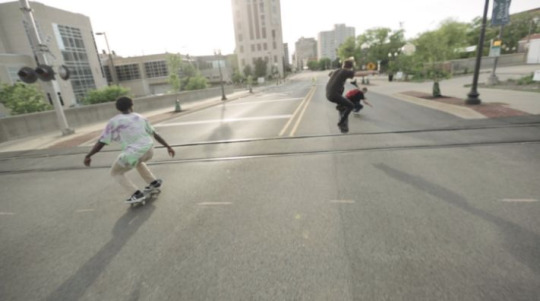
12. Minding the Gap (Bing Liu)- In part because it's produced by Steve James, Minding the Gap's easy short-hand is "Hoop Dreams for skateboarding." Because most of the film's pleasures come from following the subjects over the course of five or six years, that makes sense. What differs is that director Bing Liu is so young, which makes this a promising film if a less definitive one than James's feature debut. It’s trying to do so much, but it never feels calculated or constructed as it expands. Boldly, Liu seems to suggest that people don't really change that much, that what drives them or gnaws at them just manifests itself in different ways. The cycle of abuse ends up being a common element for the three skaters, and, as Liu admits on camera, domestic violence is the reason he made the film. (The treatment of it is raw, a blunt object when a more delicate instrument might work better.) He got the hard part right though: delicately getting us to care about people who sometimes don't care about themselves. 11. A Quiet Place (John Kransinski)- Strong early Shyamalan vibes from this lean chiller. Krasinski's directing debut, Brief Interviews with Hideous Men, didn't do much for me, and I skipped his obligatory man-comes-back-to-hometown-because-his-mom's-dying follow-up. But the filmmaking really impressed me here just by understanding how to set the table of this kind of movie. A close-up on an important nail sticking out of a floorboard here, an effortless explanation of a rule there. The hang-up for a film this high-concept is that you get distracted by all of the unanswered questions. (How did he get a printer quiet enough to print out all of those radio call signals?) But this world is fleshed out enough, especially an eerie dinner sequence, to bypass that kind of stuff for me. More than anything, there's a sort of elasticity of shot selection that serves the suspense. A tender early scene in which the central couple is dancing while wearing headphones goes on for maybe twice as long as one might expect. So later, the cross-cuts and smash-cuts have even more weight because the camera was allowed to linger earlier. Here's maybe the biggest reason for the movie's success: The characters are all slightly smarter than the audience, whereas the temptation might have been to go the other way with it. 10. Black Panther (Ryan Coogler)- I don't know if I can add anything to the discourse on this meditative yet ambitious film. I do think one early scene points at what makes it special for the genre. When T'Challa is first named king, he has to be drained of the Black Panther powers to fight anyone who wishes to challenge the throne. A member of an outsider tribe challenges him and nearly beats him. It shows a) the world-building of this noble, fair culture, b) the existence of this fully developed clan that will be important later, c) just how human T'Challa is if his reign can come so perilously close to ending just as it has begun. Every scene like that has a logical purpose. Of course, once Killmonger, the best, most realistically motivated Marvel villain of all time, gets introduced, we return to that method of challenging the throne, and writers Ryan Coogler and Joe Robert Cole aren't afraid to let the worst possible thing happen to T'Challa. What occurred forty-five minutes earlier makes this fight seem like a fait accompli. And it's in this sort of narrative detail that the film is able to work up to its thematic purpose. The first half is about, to quote T'Chaka, whether a good man can be a good king. But the second half is about the responsibility of goodness. Show me where Iron Man bit off that much. 9. Support the Girls (Andrew Bujalski)- Although it takes place mostly in one location during one day, Support the Girls has a bigger world going on in its margins. We hear it on radios, or we see it in the people taking a pitstop in Double Whammies while they're on their way somewhere better. But the force that's really encroaching on the characters' insulated environment is Mancave, the national chain that threatens to put them out of business. "They have commercials and everything," one character complains, and we get snatches of those commercials that were presumably directed by Andrew Bujalski himself. It's ten seconds of content maybe, shot in a bigger, broader style than the modest approach of the rest of the film. But the key to understanding how far Bujalski has come is realizing that he is no longer making fun of the people in the commercial, even if they're jacked bros screaming for a boxing match. That portrayal is amplified, sure, but Bujalski is mature enough now to not ridicule those people. It's okay that they're just not the people he's interested in. He's supernaturally empathetic toward the rogue's gallery of people he is interested in, who spin the ordinary challenges of the working class into something extraordinary. The sunniest member of the team is played by Haley Lu Richardson, who deserves special recognition as the indefatigable Maci. I can't think of parts that are much different from her roles in this, Columbus, and Split, to the extent that people probably don't realize they're played by the same woman, but she rules in every single one. The sky is the limit for her. When a workplace is described as "a family," it's usually just a way for the boss to take advantage of workers when the "family" designation does nothing to help them: "I know I shouldn't ask you to work off the clock, but can you help me out as a FAMILY MEMBER?" Occasionally though, it does feel like a family when people work closely to one another for hours on end and depend upon one another for real life needs. This movie is about what happens when a work family is both control and support.
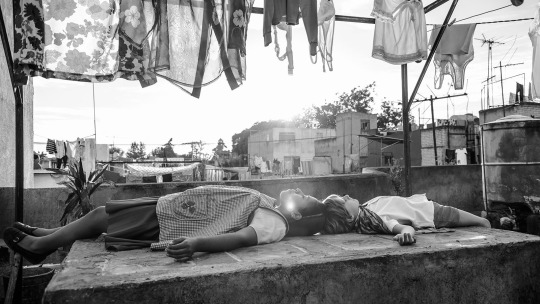
8. Roma (Alfonso Cuaron)- The trailer for Children of Men advertises itself as "from the director of The Prisoner of Azkaban and Y Tu Mama Tambien," and I remember an audience giggling at that strange CV. For one thing, at the time people didn't understand yet why someone would brag about contributing to a Harry Potter movie. But to pair that children's picture with either a Spanish title they hadn't heard of or a movie that they knew was sexually explicit? Who was this guy? Roma is who he is. I like some of his other films more--I would argue that his approach hurts the performances here--but it seems impossible for him to make anything this personal again. The baldly emotional highs that it reaches come not only from the direct simplicity of the story but also from the sophisticated perspective with which it's being downloaded directly from Cuaron's memory. (It's also, accidentally or purposefully, quite a political film at this moment in time. It insists, sometimes in the dialect of Mixtec, that these people around us silently washing dishes or picking up dog poo are, in fact, part of our family.) There's a moment when one brother throws something at another's head, barely missing, and they both stop in their tracks with fear about how tragically things could have ended up. My dad experienced a similar moment in his childhood, and he would tell the same story about Uncle Steve throwing a shoe at him any time we passed the wooden door with a dent in it at my grandma's house. What a tiny moment to live on for decades, in tangible and intangible ways. Cuaron claims that all of these moments shape us, and taking us to the moon was only a warm-up for resurrecting them for us. 7. Happy As Lazzaro (Alice Rohrbacher)- Alice Rohrwacher won the screenplay award at Cannes, probably because her script for Happy As Lazzaro is fundamentally unpredictable. Games of checkers are unpredictable though. That word doesn't quite cover the way the viewer is forced to guess at something as elemental as "What year is this taking place?" And none of the twists and turns of the storytelling--I refuse to spoil--would gel if Rohrwacher as a director wasn't teaching you how to watch the film the whole time with a rich, warm, light touch. Considering the purity of this vision as a fable, buoyed by realistic labor concerns on the other hand, it's a pity that people are calling Birdbox "crazy" when something like this is just a few clicks down on that service. 6. The Favourite (Yorgos Lanthimos)- When assessing The Favourite, the easy temptation is to say that because it isn't stuffy, because of its scabrous wit or its intimate filming techniques, that it "isn't your mother's chamber drama." It is invigorating, but in a lot of ways, the film isn't saying anything that the average Masterpiece Theater production doesn't. Instead it takes cultural touchstones about the emptiness of power and distorts them, much like the fish-eye lenses that Yorgos Lanthimos favors to photograph the palace. It says an easy thing in a hard way, with conviction to burn. Lanthimos seems freed by not having to write the screenplay, and every decision of his is rooted in making things more narrow. The barrel distortion of the fish-eye seems apt for this idea, but so do the secret passageways that Queen Anne gets wheeled through to avoid the lower rungs of the estate. Of course there's no outside world to intrude upon her majesty. But there's even an inner world to the inner world. (It's impossible to watch Olivia Colman's gonzo depiction of Anne's incurious indolence and not think of Trump.) I'm convinced that Emma Stone can do anything, and the final shot, an all-timer, only validates that suspicion. 5. Don’t Worry, He Won’t Get Far on Foot (Gus Van Sant)- You have to check out every Gus Van Sant movie, even after a few missteps, because you never know: He might take the emotional climax that you didn't even know you wanted and score it to inter-diegetic "Still Rock 'N Roll to Me," thus grounding real poignance with even realer goofiness.I'll admit that the bar is low, but this is probably the most authentic, least treacly movie ever made about addiction recovery. Van Sant, who wrote, directed, and edited, tells the story with patient command. We take Joaquin Phoenix for granted at this point, but everybody on the poster is exceptional. And Udo Kier gets to say, "Pop, pop. It's always about penises." INSTANT CLASSICS
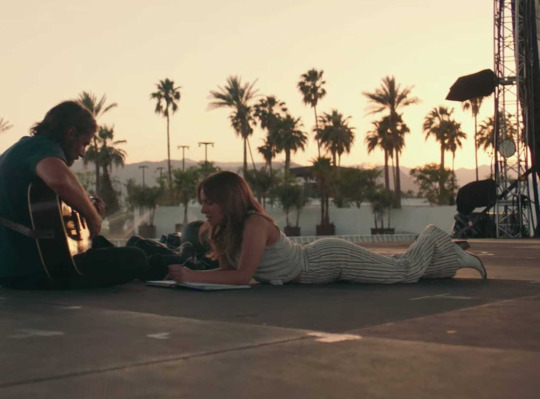
4. A Star Is Born (Bradley Cooper)- In one scene Cooper's Jackson Maine wears a black leather jacket under a brown leather vest, and the movie itself risks that kind of hat-on-a-hat silliness and redundancy. But instead it comes off as the best kind of big swing, a comforting and warm serving of Old Hollywood. Cooper's camera knows how to embrace silence and let the leads play off each other to craft raw, touching performances. Sometimes the close-ups are so intense and focused that, when he cuts back to a master, it's disorienting to be reminded that there are other people in that space, in the world at all.The movie's deficiencies come from "Wait, how much time has passed?" moments in the writing, problems that I always have had with Eric Roth projects. But it's easy to get swept up in a movie of moments that believes so much in itself.

3. Mission: Impossible- Fallout (Christopher McQuarrie)- The pattern of Mission: Impossible- Fallout is: infodump that explains the stakes and the strategy of what we're about to see, followed by an action sequence that is somehow even more thrilling than the one that came before it. Imagine a really interesting day of grade school classes, in which you learned, like, multiplication, followed by recess every other period. As for T.C., what more could you possibly want out of a human being?
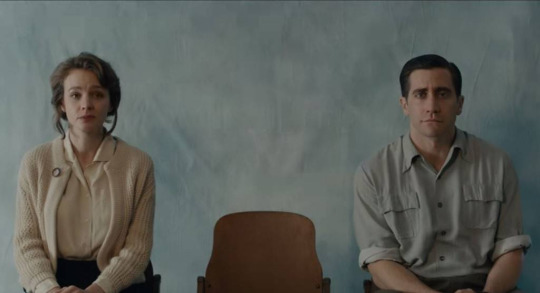
2. Wildlife (Paul Dano)- When Jerry, Jake Gyllenhaal's groundskeeper of pathetic pride, figures out that his boss is about to fire him in front of his son, he smiles and, through clenched teeth, asks if this talk can happen tomorrow. Part of him actually believes that postponing the meeting will help; maybe the boss's temper will cool overnight. But this is a man who is bound by the same desperate spirit as his wife Jeanette, who muses, "Tomorrow something will happen that will make us feel different." When people are living day-to-day, clinging to their dignity--he refers to himself as a "small person" at one point--tomorrow really does offer a regenerative power. Those characters are the same-pole magnets that inform this coming-of-age tale, and the subtext of the film is "Can you believe Carey Mulligan and Jake Gyllenhaal have a fourteen-year-old son?" It works for the 1960 setting because these are people who defined themselves before they knew who they were, and they'll now do anything to re-define themselves as brave/sexy/valuable. But it works for the actors too. Gyllenhaal in particular is tender and heartbreaking in a true supporting role, allowing himself to look his age, framing himself with the dad akimbo arms. But Mulligan's fake confidence is great too, especially in a scene in which she nearly begs her husband to let her work. Something tells me that I should credit a director for coaxing two career best performances from two great actors. Some people just have it, and Paul Dano does.
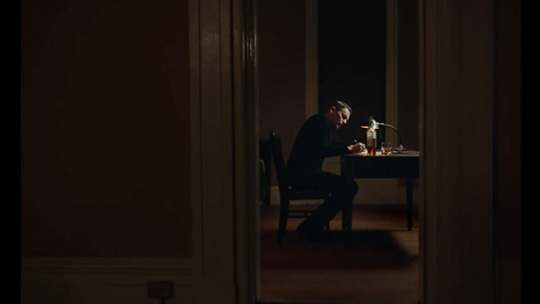
1. First Reformed (Paul Schrader)- In 1998 I dragged my father to see Paul Schrader's Affliction, a movie that was kind of about my father's father. When the end credits rolled on that bleak, wrenching film, my dad turned to me and said, "I feel like I have to take a shower." We walked around a nearby hotel and talked for an hour, not that he was able to articulate why he was so shaken. We discussed the difference between entertainment and art and what makes a piece of either successful. Even though he hated the experience, he couldn't deny that it was an experience. He kept on saying, "That's not why I go to the movies." And no matter what I, fifteen at the time, told him, he couldn't understand that's exactly why I go to the movies. First Reformed had the same mesmerizing effect as the best of Schrader's work: When I exited the building, I stumbled into the sunlight because I had been trapped in someone else's mind for almost two hours.
Part of that effect comes from the narrative device of Reverend Toller's journal, which plants us in his headspace from the beginning. Part of it comes from the intimate scale of the film, which features only a handful of locations. But if what I'm explaining seems small, then I'm doing a bad job. The canvas expands. Schrader insists that our care for the environment is our most immediate responsibility; this film historian has no problem with planting the film at 2017 in dialogue. And that emphasis is matched only by his disdain for how big business encroaches on personal aspects of our lives. There's even a scene that tries to account for a recent rise in extremism among young people. As if to prove that he isn't being pedantic, he has one character communicate one of those ideas, letting you assume that role is his mouthpiece, then he has another character reply with something just as convincing. First Reformed weaves in those elements, but it's ultimately a character piece that humanizes the type of person we think we know but for which we have no frame of reference. In Ethan Hawke's piercing performance, we see a Reform minister who punishes himself actively and passively for what he thinks are sins. He uses faith as an armor and as an excuse, being so of the mind and--as another character puts it--"in the garden" that he denies himself medical care. No matter what anyone else tells him, he is convinced of one of the tenets that Schrader could never shake from his Calvinist upbringing: There's nothing you can do to save yourself.
2 notes
·
View notes